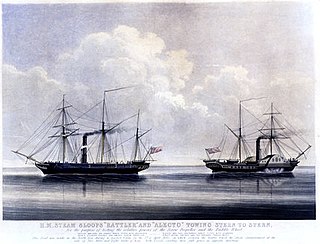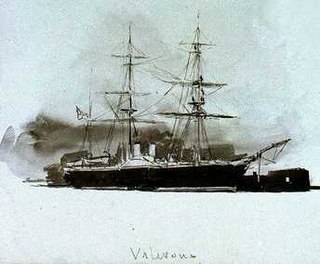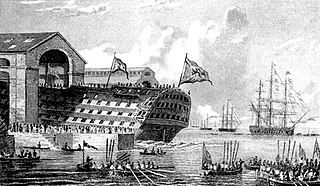
HMS Aetna was the mercantile Success launched in 1803 at Littlehampton. The Admiralty purchased here in 1803 to convert her to a Royal Navy bomb vessel. Aetna participated in the second Battle of Copenhagen in 1807 and the Battle of the Basque Roads in 1809. Later, she participated in the attack on Fort McHenry in the Battle of Baltimore and the bombardment of Fort Washington, Maryland in 1814, during the War of 1812. The Navy sold her in 1816 and she returned to mercantile service under her original name. She sailed to Calcutta, to Rio de Janeiro, and more locally until she was wrecked in 1823.

HMS Rattler was a 9-gun steam screw sloop of the Royal Navy, and one of the first British warships to be completed with screw propulsion. She was originally ordered as a paddle wheel 4-gun steam vessel from Sheerness Dockyard on 12 March 1841. She was reordered on 24 February 1842 as a propeller type 9-gun sloop from HM Royal Dockyard, Sheerness, as a new vessel. William Symonds had redesigned the ship as a screw propeller driven vessel.

HMS Vulture was one of three 6-gun, steam-powered Cyclops-class second-class paddle frigates built for the Royal Navy in the 1840s. She was initially deployed to the East Indies where she participated in actions against China and then played a minor role in the Crimean War of 1854–1855. The ship was sold for scrap in 1863.

HMS Miranda was a 14-gun wooden screw sloop of the Royal Navy. As part of the 1847 Program, she was designed by John Fincham, Master Shipwright of Portsmouth and is considered an improved Rattler with the design approved on 3 November 1847. She was ordered on the 25th of April 1847 with the name Grinder from Royal Dockyard, Sheerness. On the 3rd of November 1847 she was reordered as the Miranda from Sheerness Dockyard. Launched in 1851, she was completed to see action in the Russian War of 1854 - 55. In 1854 she was in the White Sea and participated in the bombardment of the Port of Kola. She then participated in the Sea of Azov during 1855. Two of her crew were awarded the Victoria Cross for their bravery. Towards the end of her career she transported troops during the New Zealand war. She was reclassified as a corvette by 1862, She was sold for breaking in December 1869.

HMS Valorous was one of two 16-gun, steam-powered Magicienne-class second-class paddle frigates built for the Royal Navy in the 1850s. Commissioned in 1853 she played a small role in the Crimean War of 1854–1855 and was sold for scrap in 1891.

HMS Coromandel was a wooden paddle dispatch vessel of the Royal Navy. She was built for the P&O company as the passenger and cargo steamer Tartar. The Navy purchased her in 1855 and she participated in several battles in Chinese waters, including having been sunk and recovered. The Navy sold her in 1866 and she went through several changes in ownership before she was broken up in 1876.

The Aetna-class ironclad floating batteries were built during the Crimean War for the attack of Russian coastal fortifications.

HMS Magicienne was the lead ship of her class of two 16-gun, steam-powered second-class paddle frigates built for the Royal Navy in the 1850s. Commissioned in 1853 she played a small role in the Crimean War of 1854–1855 and was sold for scrap in 1866.
Tsesarevich was a wooden-hulled, steam-powered, first-rate ship of the line built for the Imperial Russian Navy in the mid-1850s. Intended to serve with the Black Sea Fleet, she was transferred to the Baltic Fleet before her engine was installed in accordance with the terms of the Treaty of Paris that ended the Crimean War. Built of unseasoned oak, Tsesarevich saw little service, before she was stricken from the Navy Directory in 1874.

The Albacore-class gunboat, also known as "Crimean gunboat", was a class of 98 gunboats built for the Royal Navy in 1855 and 1856 for use in the 1853-1856 Crimean War. The design of the class, by W. H. Walker, was approved on 18 April 1855. The first vessels were ordered the same day, and 48 were on order by July; a second batch, which included Surly, were ordered in early October.
HMS Endeavour was a 4-gun bomb vessel of the Royal Navy, purchased in 1694 but sold out of service the following year.
HMS Sinbad was a 60-foot (18.3 m) lighter built for the Royal Navy during the 1830s. She was converted into a bomb vessel during the Crimean War of 1854–55 and converted back into a lighter after the war. The ship was broken up in 1866.

HMS Volage was a sixth-rate sailing frigate launched in 1825 for the Royal Navy. At one point geologist Thomas Abel Brimage Spratt served aboard her.

Rossiya was the 120/128-gun first-rate ship of the line built for the Imperial Russian Navy in the late 1830s. The ship was assigned to the Baltic Fleet for her entire career. She was one of the ships deployed to Denmark during the First Schleswig War of 1848–50. She took part in the defence of Sveaborg during the Crimean War. Rossiya was decommissioned in 1856 and sold for scrap in 1860.

HMS Leander was a 50-gun frigate of the Royal Navy which saw service in the Crimean War.
HMS Surly was a Cheerful-class cutter built in 1806. Carrying 12 guns she served during the Napoleonic Wars and helped to capture a French privateer in 1809. In 1825 she was employed in carrying quantities of coin between Dublin and London and also in suppressing strike action by seamen on the River Wear. Her duties assisting the civil authorities at the Wear and later on the River Tyne extended into 1827. Surly later served on the Scottish coast and on anti-smuggling patrols in the Thames Estuary. She was refitted as a lighter in 1833 and sold out of service in 1837.

HMS Surly was an Albacore-class gunboat built for the Royal Navy. She was constructed in Newcastle by T & W Smith as part of the second batch, ordered in early October 1855, and was launched on 18 March 1856. After commissioning she served in the Steam Reserve and Coastguard Reserve. She was sold out of service in 1869.
HMS Rhadamanthus was one of the initial steam powered vessels built for the Royal Navy. On 10 January 1831 the First Sea Lord gave orders that four paddle vessels be built to competitive designs. The vessels were to be powered by Maudslay, Son & Field steam engines, carry a schooner rig and mount one or two 10-inch shell guns. Initially classed simply as a steam vessel (SV), she was re-classed as a second-class steam sloop in 1846. Designed by Thomas Roberts, the Master Shipwright of Plymouth. She was launched and completed in 1832, She was converted into a transport in 1841 then in 1851 she was a troopship and by the 1860s she was a transport again. Her breaking was completed in February 1864.
HMS Stromboli was initially a Steam Vessel second class designed by Sir William Symonds, Surveyor of the Navy, and built at Portsmouth. She was commissioned and participated in the bombardment of Acre in 1840, during the Russian War she was used as a troop transport in the Baltic in 1854, she was in the Black Sea and the Sea of Azov in 1855. Her last overseas posting was on the South East Coast of America. She was sold for breaking in August 1866.












